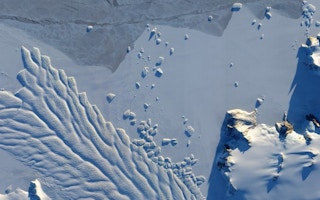Arctic sea ice is retreating, with projections suggesting that the summer months will be substantially ice-free within the next few years. Nations are waking up to the possibilities for shipping and resource exploration this brings. But for all the potential economic benefits they glimpse, none have taken on board the hidden costs of an Arctic thaw.
Trapped beneath the permafrost are billions of tonnes of methane, a powerful greenhouse gas. If the Arctic thaws, some 50 gigatonnes (Gt) of methane could be abruptly released at any time from the East Siberian Arctic Shelf area alone.
If this happens between 2015 and 2025 it will bring forward the moment the mean global temperature rises by more than 2C by about 15 years, from 2050 to 2035. The methane pulse would increase the overall economic cost of global warming and subsequent climate change worldwide by 15%, around $60 trillion. As this is only slightly less than the entire planet’s annual economic output, this sudden methane release is sufficiently worrying to justify urgent action to prevent it happening.
The model we use, the PAGE09 integrated assessment model, employs simple equations to simulate the results from more complex, specialised scientific and economic models. It does this while accounting for the profound uncertainty that exists around climate change. Calculations are made for eight world regions, ten time periods to the year 2200, for four types of impact (sea level rise, economic impacts, non‐economic impacts, and discontinuities, such as the melting of the Greenland and West Antarctic ice sheets).
The peak effect of the methane pulse on global mean temperature will come in 2040. Without the additional methane, the maximum temperature rise by 2040 is just under 3.5°C; with it there is a 2% chance this could be exceeded, with the temperature rise perhaps going as high as 4.5°C by 2040. By 2100 the methane’s effect is much reduced as most has now disappeared from the atmosphere, raising the mean temperature by only 0.2°C compared to the rise that would have been expected without the methane release.
These effects were calculated from 10,000 runs of the PAGE09 model. The solid lines are the mean results from the model; the dashed lines show the 5% and 95% probability results.

Mean global mean temperature rise (°C), with and without 50Gt methane release. Chris Hope
With higher temperatures brought about by a sudden burst of methane come greater impacts, including a greater chance that the Greenland and West Antarctic ice sheets will melt. The mean cost of these extra impacts peak at about $1.2 trillion per year in 2075. Without the additional methane the mean cost of the impacts of climate change is $396 trillion; with the pulse this rises to $458 trillion, an increase of about 15%. There is a 5% chance the extra impacts could cost more than $225 trillion. Some 80% of these costs will be borne by developing countries, as they experience more extreme weather, flooding, droughts and poorer health.

Extra annual climate impacts brought on by methane release. Chris Hope
These scenarios assume the entire 50Gt of methane is released between 2015 and 2025. But alternative scenarios provide roughly similar results. For example, a 10-year scenario, where the methane emerges between 2025 and 2035 or between 2035 and 2045, would have a mean cost of between $60 and 63 trillion. A 20-year scenario between 2015 and 2035 would have a mean cost of $64.5 trillion, and a 30-year scenario between 2015 and 2045 would have a mean cost of $66 trillion. The 30-year release generates slightly but significantly greater impacts than a 10-year release. This is because more methane remains in the atmosphere in the period when impacts are expected to be higher.
As this model and analysis assumes that a giant methane release has the same warming effect and acts in the same way as we understand current greenhouse gas emissions to act, we may well be underestimating the effects. There is some evidence that such a large release in the Arctic would take longer to disperse than less concentrated emissions spread elsewhere. It also assumes the temperature rise from the methane does not trigger other methane releases that would not otherwise have occurred – which may also lead to a potential underestimation of the effects.
These vast economic impacts of a changing Arctic landscape far outweigh any short-term gains from easier shipping and resource extraction. Almost every economic discussion of Arctic change today, including those of the World Economic Forum, the International Monetary Fund, and other international bodies, has failed to understand this vast economic danger – none have seen the big picture.
Chris Hope is a reader in policy modelling at the University of Cambridge and formerly a specialist advisor to the House of Lords Select Committee on Economic Affairs Inquiry into aspects of the economics of climate change. This post originally appeared here.










